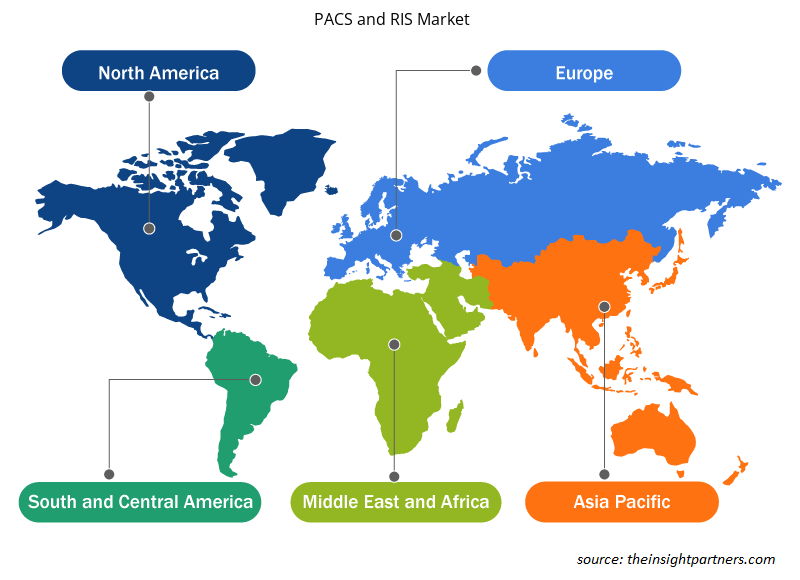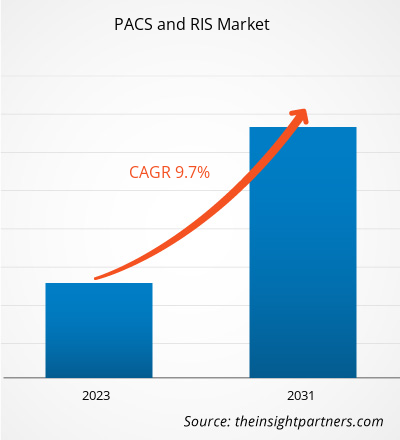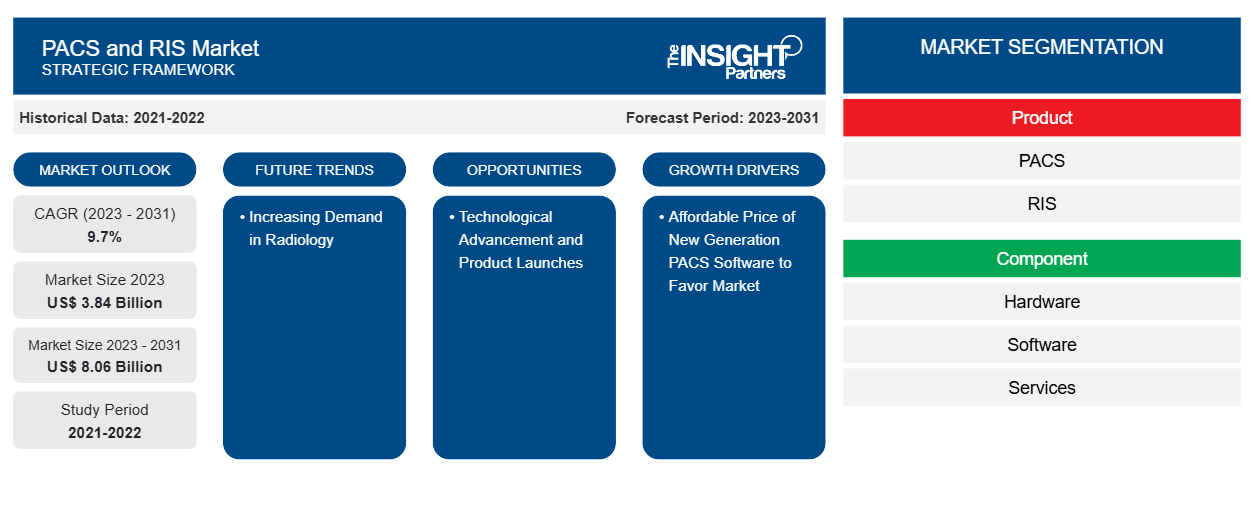La taille du marché des PACS et RIS devrait atteindre 8,06 milliards USD d'ici 2031, contre 3,84 milliards USD en 2023. Le marché devrait enregistrer un TCAC de 9,7 % en 2023-2031. Les avancées technologiques et les lancements de produits resteront probablement une tendance essentielle du marché des PACS et RIS.
Analyse du marché des PACS et des RIS
Les compétences liées au PACS redéfinissent le potentiel de l'imagerie médicale diagnostique et transforment les possibilités de soins aux patients. Les principaux facteurs à l'origine de la croissance du marché des PACS et RIS sont l'utilisation de l'intelligence artificielle (IA) en radiologie et en imagerie médicale et les systèmes combinés RIS/PACS. L'IA intégrée améliore le processus de décision radiologique à un niveau plus exploitable, principalement en raison des factions progressives dans le développement des algorithmes et de la disponibilité accrue des ressources informatiques. En outre, de nombreuses entreprises et praticiens de l'imagerie médicale passent des systèmes PACS sur site aux solutions PACS cloud. Ce changement immédiat est principalement dû à des avantages tels que la rentabilité, l'évolutivité et la sécurité des données.
Aperçu du marché des PACS et des RIS
Le diabète, les accidents vasculaires cérébraux, les maladies cardiaques, le cancer et d'autres maladies chroniques sont les principales causes de décès qui nécessitent plusieurs systèmes d'imagerie sensorielle à des fins de diagnostic et de suivi du traitement. L'utilisation du PACS offre divers avantages aux patients et augmente l'efficacité des hôpitaux dans le traitement des maladies chroniques. Le PACS dans les hôpitaux réduit les temps d'examen et d'attente des patients. Il fournit également un traitement approprié aux patients atteints de maladies chroniques , offrant ainsi une opportunité de croissance significative pour le marché dans les années à venir.
Personnalisez ce rapport en fonction de vos besoins
Vous bénéficierez d'une personnalisation gratuite de n'importe quel rapport, y compris de certaines parties de ce rapport, d'une analyse au niveau des pays, d'un pack de données Excel, ainsi que de superbes offres et réductions pour les start-ups et les universités.
-
Obtenez les principales tendances clés du marché de ce rapport.Cet échantillon GRATUIT comprendra une analyse de données, allant des tendances du marché aux estimations et prévisions.
Facteurs moteurs et opportunités du marché des PACS et des RIS
Le prix abordable du logiciel PACS de nouvelle génération favorisera le marché
Les PACS modernes sont disponibles à un prix plus abordable que les versions plus anciennes. Les prix varient en fonction du volume d'études, de la taille du cabinet et des intégrations particulières nécessaires. 1 000 études PACS sur site peuvent coûter moins de 10 000 USD par mois et les frais annuels de maintenance et d'assistance s'élèvent à 2 000 USD. Le PACS sur site est moins coûteux que le PACS basé sur le cloud. De plus, le coût de stockage peut atteindre 50 USD, soit 5 % du coût précédent. De plus, le prix du logiciel pour une utilisation mensuelle est de 1 500 USD, hors configuration préliminaire et poste de visualisation compatible Internet ou ordinateur personnel. Les facteurs ci-dessus stimulent la croissance du marché des PACS et des RIS.PACS are available at affordable price than its older versions. Pricing varies based on volume or studies, the practice size, and particular integrations needed. On-site 1,000 PACS studies can cost less than US$ 10,000 for a month and annual maintenance and support fees of US$2,000. On-site PACS is less costly than cloud-based PACS. Furthermore, the storage cost is up to US $50, i.e., 5% of the earlier cost. Also, the software price for a month usage is US$1,500, excluding the preliminary setup and an internet-capable viewing station or personal computer. The above factors is driving the PACS and RIS market growth.
Demande croissante en radiologie – Une opportunité sur le marché des PACS et RISPACS and RIS Market
Le système d'information radiologique (RIS) et le système d'archivage et de communication d'images (PACS) sont deux solutions principales pour maintenir et gérer l'imagerie organisationnelle dans le domaine de la radiologie. Le RIS gère efficacement le flux de données tout au long du traitement des rapports, tandis que le PACS transporte efficacement les informations d'imagerie médicale privées des patients. Après l'intégration du RIS et du PACS, les professionnels de la santé accèdent facilement aux images médicales, réduisant ainsi les refus de réclamations dus à des informations mal saisies. D'autres facteurs tels que le suivi des images, les rapports de procédures spécifiques, la facturation automatisée et d'autres aident les professionnels de la radiologie à suivre les données des patients. Ainsi, la croissance du marché des PACS et du RIS est propulsée.RIS) and Picture Archiving and Communication System (PACS) are two primary solutions to maintain and manage organization imaging in the field of radiology. RIS efficiently manages data flow throughout reporting processing, whereas PACS efficiently transports private patient medical imaging information. After integrating RIS and PACS, healthcare professionals access medical images easily, reducing claims denials due to incorrectly entered information. Other factors such as image tracking, specific procedure reporting, automated billing, and other is helping PACS and RIS Market.
Analyse de segmentation du rapport sur le marché des PACS et des RIS and RIS Market Report Segmentation Analysis
Les segments clés qui ont contribué à l’élaboration de l’analyse du marché PACS et RIS sont les produits, les composants, le déploiement et l’utilisateur final.PACS and RIS market analysis are product, component, deployment, and end user.
- En fonction du produit, le marché des PACS et RIS est divisé en deux segments : les PACS et les RIS. Le segment des PACS détenait une part de marché plus importante en 2023.PACS and RIS market is bifurcated into PACS and RIS. The PACS segment held a larger market share in 2023.
- En fonction des composants, le marché est segmenté en matériel, logiciels et services. Le segment des logiciels détenait une part de marché plus importante en 2023.
- En fonction du déploiement, le marché est divisé en deux segments : sur site et basé sur le Web et le cloud. Le segment basé sur le Web et le cloud détenait une part de marché plus importante en 2023.
- En termes d'utilisateur final, le marché est divisé en hôpitaux, centres de diagnostic, instituts de recherche et universitaires, et autres. Le segment hospitalier a dominé le marché en 2023.
Analyse des parts de marché des PACS et des RIS par zone géographique
Français La portée géographique du rapport sur le marché des PACS et RIS est principalement divisée en cinq régions : Amérique du Nord, Europe, Asie-Pacifique, Moyen-Orient et Afrique, et Amérique du Sud/Amérique du Sud et centrale. Le marché des PACS et RIS en Amérique du Nord est important. Le marché des PACS et RIS est en croissance et connaît une croissance exponentielle en Amérique du Nord. La croissance de la région est principalement tirée par les investissements gouvernementaux dans les infrastructures de santé, la sensibilisation accrue à l'imagerie médicale et à ses avantages associés à la mise en œuvre des PACS et RIS. En mars 2024, Synthesis Health a lancé un développeur de plateforme de flux de travail en radiologie. Cette plateforme comprend plusieurs modules, notamment une capacité de reconnaissance vocale basée sur l'IA, un package de flux de travail et de création de rapports, ainsi qu'un visualiseur de diagnostic et d'entreprise. Les facteurs ci-dessus devraient avoir un effet positif sur la croissance du marché des PACS et RIS.
Aperçu régional du marché des PACS et des RIS
Les tendances et facteurs régionaux influençant le marché des PACS et RIS tout au long de la période de prévision ont été expliqués en détail par les analystes d'Insight Partners. Cette section traite également des segments et de la géographie du marché des PACS et RIS en Amérique du Nord, en Europe, en Asie-Pacifique, au Moyen-Orient et en Afrique, ainsi qu'en Amérique du Sud et en Amérique centrale.

- Obtenez les données régionales spécifiques au marché des PACS et RIS
Portée du rapport sur le marché des PACS et des RIS
| Attribut de rapport | Détails |
|---|---|
| Taille du marché en 2023 | 3,84 milliards de dollars américains |
| Taille du marché d'ici 2031 | 8,06 milliards de dollars américains |
| Taux de croissance annuel composé mondial (2023-2031) | 9,7% |
| Données historiques | 2021-2022 |
| Période de prévision | 2023-2031 |
| Segments couverts |
Par produit
|
| Régions et pays couverts |
Amérique du Nord
|
| Leaders du marché et profils d'entreprises clés |
|
Densité des acteurs du marché : comprendre son impact sur la dynamique des entreprises
Le marché des PACS et RIS connaît une croissance rapide, tirée par la demande croissante des utilisateurs finaux en raison de facteurs tels que l'évolution des préférences des consommateurs, les avancées technologiques et une plus grande sensibilisation aux avantages du produit. À mesure que la demande augmente, les entreprises élargissent leurs offres, innovent pour répondre aux besoins des consommateurs et capitalisent sur les tendances émergentes, ce qui alimente davantage la croissance du marché.
La densité des acteurs du marché fait référence à la répartition des entreprises ou des sociétés opérant sur un marché ou un secteur particulier. Elle indique le nombre de concurrents (acteurs du marché) présents sur un marché donné par rapport à sa taille ou à sa valeur marchande totale.
Les principales entreprises opérant sur le marché des PACS et RIS sont :
- Groupe Agfa-Gevaert
- INFINITT Healthcare Co., Ltd.
- Société McKesson
- Société Cerner
- Compagnie Générale d'Électricité
- Royal Philips NV
Avis de non-responsabilité : les sociétés répertoriées ci-dessus ne sont pas classées dans un ordre particulier.

- Obtenez un aperçu des principaux acteurs du marché PACS et RIS
Actualités et développements récents du marché des PACS et RIS
Le marché des PACS et RIS est évalué en collectant des données qualitatives et quantitatives après des recherches primaires et secondaires, qui comprennent d'importantes publications d'entreprise, des données d'association et des bases de données. Voici une liste des développements sur le marché des innovations, de l'expansion commerciale et des stratégies :
- En mai 2024, le système de santé américain Change Healthcare a lancé le PACS Cloud-Native. L'entreprise se concentre sur la transition des systèmes d'imagerie sur site vers des solutions d'imagerie médicale basées sur le cloud et sans empreinte, le PACS et ses outils associés pour la cardiologie et la radiologie (Source : Change Healthcare, communiqué de presse)
- En septembre 2023, à l'occasion de la Journée mondiale de la sécurité des patients 2023, la Patient for Patient Safety Foundation (PFPSF) et le Consortium of Accredited Healthcare Organizations (CAHO) ont uni leurs forces pour souligner l'importance de l'engagement des patients par la création de conseils consultatifs de patients (PAC) et la promotion des mesures d'expérience rapportée par les patients (PREM) (Source : Patient for Patient Safety Foundation (PFPSF), Newsletter)
Rapport sur la couverture et les livrables du marché PACS et RIS
Le rapport « Taille et prévisions du marché des PACS et RIS (2021-2031) » fournit une analyse détaillée du marché couvrant les domaines suivants :
- Taille et prévisions du marché des PACS et RIS aux niveaux mondial, régional et national pour tous les segments de marché clés couverts par le périmètre
- Dynamique du marché, comme les facteurs moteurs, les contraintes et les opportunités clés
Tendances du marché des PACS et RIS
- Analyse détaillée des cinq forces de PEST/Porter et SWOT
- Analyse du marché PACS et RIS couvrant les principales tendances du marché, le cadre mondial et régional, les principaux acteurs, les réglementations et les développements récents du marché
- Analyse du paysage industriel et de la concurrence des PACS et RIS couvrant la concentration du marché, l'analyse de la carte thermique, les principaux acteurs et les développements récents
- Profils d'entreprise détaillés
- Analyse historique (2 ans), année de base, prévision (7 ans) avec TCAC
- Analyse PEST et SWOT
- Taille du marché Valeur / Volume - Mondial, Régional, Pays
- Industrie et paysage concurrentiel
- Ensemble de données Excel
Rapports récents
Témoignages
Raison d'acheter
- Prise de décision éclairée
- Compréhension de la dynamique du marché
- Analyse concurrentielle
- Connaissances clients
- Prévisions de marché
- Atténuation des risques
- Planification stratégique
- Justification des investissements
- Identification des marchés émergents
- Amélioration des stratégies marketing
- Amélioration de l'efficacité opérationnelle
- Alignement sur les tendances réglementaires























 Obtenez un échantillon gratuit pour - Marché des PACS et RIS
Obtenez un échantillon gratuit pour - Marché des PACS et RIS